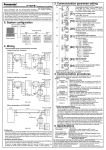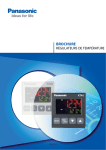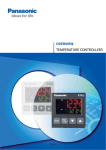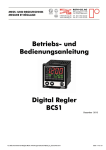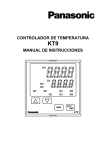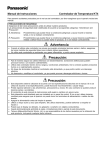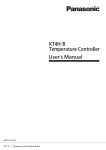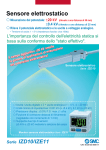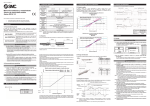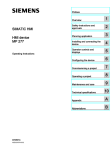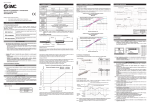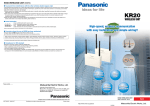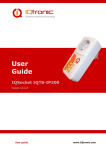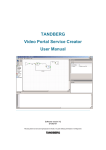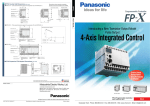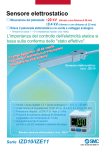Download KT4H Temperature Controller
Transcript
KT4H Temperature Controller KT4H Temperature Controller Compact Body with Numerous Features 2) 11-segment LCD improves ability to distinguish alphanumeric. 3) Largest letter height of PV value in its class for easy readability even from a distance. 2. Space savings (Depth: 56mm) Control panel installation length has been shortened to the utmost. 3. Ability to use any sensor (input) is inherited from KT Series The KT4H comes standard with ability to use any sensor (input): thermocouple (10 types), RTD (2 types), DC current (2 types), and DC voltage (4 types) 4. Simple operation enables highly accurate temperature control The operation mode uses “PID control” which allows a stable temperature to be maintained. Capable of high accuracy with an input span of ±0.2% and a highspeed sampling period of 250 ms. 5. Improved communication functions 1) MEWTOCOL communications protocol is built in. Up to 31 temperature controllers can be connected and data can be collected using a DLU (Web RoHS Directive compatibility information http://www.mew.co.jp/ac/e/environment/ FEATURES 1. Better visibility 1) The KT4H uses our time-proven display system (negative type LCD + LED backlight) that is used in our timers and counters. Datalogger Unit) or similar. 2) Using the external tool port, all settings can be loaded and settings can be made. 6. Easier operation 1) The switch layout has been changed and mode changes easier using the front keys. 2) Improved switch construction provides a much more positive clicking action. 7. Protective construction Despite its compact size, protective structure conforms to IP66 (front panel only, when using rubber packing). 8. Improved control functions (option) 1) Capable of 4-point temperature selection by external input. 2) Control output can be turned ON and OFF externally. 3) 3-phase heater burn-out detection function 4) Non-contact voltage output in heating/ cooling control output available. 9. Complies with international standards. UL and C-UL compliance. CE marking conformity. PRODUCT TYPES KT4H Series Base model AKT4H Power supply Sensor input Control output Alarm output Heating/ Heater Communications cooling control burnout alarm function 1 2 1 1 2 3 0 1 2 0 0 1 2 0 0 0 1 or 2 0 3 1 or 2 0 4 1 or 2 0 5 1 or 2 0 6 Blank 1 2 Description 100 to 240V AC 24V AC/DC Multi-input (Thermocouple, RTD, DC Voltage and DC Current) Relay contact Non-contact voltage (for SSR drive) DC current Heater burn-out alarm not possible. 1 point (1a) 2 points (1a + 1a) Heating/cooling control output not possible. Not available Relay contact Heater burn-out alarm not possible. Non-contact voltage (for SSR drive) Heater burn-out alarm not possible. Not available Single phase 20A (Heater burn-out alarm not supported when control output is DC output type/not supported when heating and cooling control is selected) Single phase 50A (Heater burn-out alarm not supported when control output is DC output type/not supported when heating and cooling control is selected) Three phase 20A (Heater burn-out alarm not supported when control output is DC output type/not supported when heating and cooling control is selected) Three phase 50A (Heater burn-out alarm not supported when control output is DC output type/not supported when heating and cooling control is selected) Not available Serial communication RS-485 Contact input Notes: 1. CT1 or CT2 for current transformer is provided as an accessory when heater burn-out alarm function is added. 2. Under some conditions, option functions (shaded items) may not be available; please check the “Descriptions” of the above table for non-functioning circumstances. ● Part No. Example: Part No. when the optional functions (Heating/Cooling control + communication function) are added on to the basic model are as follows; Part No.: AKT4H1111101 KT4H Temperature Controller ARCT1B291E ’07.10 http://www.mew.co.jp/ac/e/ New 1 Matsushita Electric Works, Ltd. KT4H Temperature Controller ● Options ● Setting software Product name Shunt resistor (for Current input) Terminal cover Tool cable Part No. AKT4810 AKT4H801 AKT4H820 Product name Description KT Monitor Editing of all types of data, File saving Monitoring of readings, Saving of log files Remark Available for download at no charge from company website. http://www.mew.co.jp/ac/e Note: Please download user manual from the company website. RATING & SPECIFICATIONS Item Specifications Size (W × H × D) Supply voltage (Must be specified) Frequency Power consumption Input type Rated graduation Rating K J R S Thermocouple B E T N PL-II C (W/Re5-26) Pt100 RTD JPt100 DC Current 4 to 20mA DC 0 to 20mA DC 0 to 1V DC 0 to 10V DC Voltage 1 to 5V DC 0 to 5V DC Multi-input –2000 to 10000 • Scaling and change to the decimal point position are possible for DC current and DC voltage input. • DC current input is supported with an externally mounted 50Ω shunt resistor (sold separately). K, J, R, S, B, E, T, N, PL-II, C (W/Re5-26) External resistor: Max. 100Ω (max. 40Ω external resistor for B input) Thermocouple RTD Pt100, JPt100Ω 3-conductor system (Allowable input conductor resistance for each conductor: max. 10Ω) DC current DC voltage 0 to 20mA DC 4 to 20mA DC 0 to 1V DC 0 to 5V DC 1 to 5V DC 0 to 10V DC Control output Relay contact (Contact material: Ag alloy) (Must be specified) Non-contact voltage DC current Alarm output 1 (EVT1) Relay contact (Contact material: Ag alloy) Alarm output 2 (EVT2) Control mode Target temperature setting Accuracy 48 × 48 × 62mm 100 to 240V AC 24V AC/DC 50/60Hz Approx. 8VA Input range –200 to 1370°C (–320 to 2500°F) –200.0 to 400.0°C (–320.0 to 750.0°F) –200 to 1000°C (–320 to 1800°F) 0 to 1760°C (0 to 3200°F) 0 to 1760°C (0 to 3200°F) 0 to 1820°C (0 to 3300°F) –200 to 800°C (–320 to 1500°F) –200.0 to 400.0°C (–320.0 to 750.0°F) –200 to 1300°C (–320 to 2300°F) 0 to 1390°C (0 to 2500°F) 0 to 2315°C (0 to 4200°F) –200 to 850°C (–320 to 1500°F) –200.0 to 850.0°C (–320.0 to 1500.0°F) –200 to 500°C (–320 to 900°F) –200.0 to 500.0°C (–320.0 to 900.0°F) Thermocouple Input impedance: 50Ω (Connect 50Ω shunt resistor between input terminals.) Allowable input current: max. 50 mA (when 50Ω shunt resistor is used) Input impedance: min. 1 MΩ, Allowable input voltage: max 5 V, Allowable signal source resistance: max. 2 kΩ Input impedance: min. 100 kΩ, Allowable input voltage: max 15 V, Allowable signal source resistance: max. 100kΩ 1a: 3A 250V AC (Resistive load), 1A 250V AC (Inductive load cosφ=0.4), Electric life: 100,000 times 12V DC±15%, Max. load current: 40mA (Short-circuit protected) 4 to 20mA DC Load resistance: Max. 550Ω Relay contact 1a: 3A 250VAC (Resistive load) Electric life: 100,000 times Same as Alarm output 1 Actions mentioned below can be selected by key operation. [Default PID] PID (with auto-tuning function), PI, PD (with manual reset function), P (with manual reset function), ON/OFF action Primary setting/secondary setting/third setting/fourth setting (switched by external terminal) Within ±0.2% of each input span ±1 digit or within ±2°C (4°F) whichever is greater However, R and S input; Within ±6°C (12°F) in the range of 0 to 200°C (32 to 400°F) B input 0 to 300°C (32 to 600°F): Accuracy is not guaranteed. K, J, T, E, and N input less than 0°C (32°F): Within ±0.4% of input span ±1 digit Within ±0.1% of each input span ±1 digit or ±1°C (2°F) whichever is greater Within ±0.2% of each input span ±1 digit RTD DC current and DC voltage Sampling period 250ms Hysteresis (ON/OFF) Thermocouple & RTD: 0.1 to 100.0°C (32.18 to 212°F) DC current and DC voltage: 1 to 1000 (The decimal point place follows the selection) Proportional band 0 to 1000°C (32 to 1832°F) The decimal point input: 0.0 to 1000°C (32 to 1832°F) DC current and DC voltage: 0.0 to 100.0% Integral time Derivative time Proportional cycle Allowable voltage fluctuation Insulated resistance Breakdown voltage Malfunction vibration Breakdown vibration Malfunction shock Breakdown shock Ambient temperature Ambient humidity Mass Waterproof Options Display character height Relay contact (Contact Heating/ Output Cooling (Must be material: Ag alloy) control specified) Non-contact voltage Heater burn-out alarm output (Relay contact material: Ag alloy) Tool port Accessories 2 Mounting frame Rubber gasket 0 to 1000 seconds 0 to 300 seconds 1 to 120 seconds When 100 to 240V AC; 85 to 264V AC When 24V AC/DC; 20 to 28V AC/DC 500V DC 10MΩ or greater 1.5kV AC for 1 min between input terminal and power terminal, & between output terminal and power terminal 10 to 55 Hz (1 cycle/min.) single amplitude 0.35 mm (10 minutes on 3 axes) 10 to 55 Hz (1 cycle/min.) single amplitude 0.75 mm (1 hour on 3 axes) X, Y & Z each direction for 5 times 98m/s2 Same as above, but 294m/s2 0 to 50°C 35 to 85%RH (No condensation) Approx. 120g IP66 (applicable only to the front panel subject to rubber gasket employed) PV: 12mm SV: 6mm Control capacity 1a: 3A 250V AC (Resistive load), Electric life: 100,000 times 12V DC±15% Max. 40mA (Short-circuit protected) Specify either single-phase 20 A, single-phase 50 A, 3-phase 20 A, or 3-phase 50 A for rated heater current. Setting accuracy: within ±5% of rated heater current Relay contact 1a: 3A 250V AC (Resistive load), Electric life: 100,000 times Communication interface C-MOS level Cannot be used at the same time as serial communication (option). *This port can only be used with the tool cable (AKT4H820). Comes with KT4H. KT4H Temperature Controller COMMUNICATION FUNCTION OVERVIEW Item Communication type Communication speed Synchronization type Protocol Coding Interface No. of nodes Maximum cable length Specifications Half-duplex Select 2400, 4800, 9600, or 19200 bps using key operation. Asynchronous Modbus RTU, Modbus ASCII, MEWTOCOL (Slave) Binary/ASCII EIA RS485 compliant 31 1,000 m (cable resistance must be within 50Ω) PARTS AND FUNCTIONS 1 1 Action indicators (backlight: orange) °F °C ..................... Lights respectively when temperature unit °F/°C is selected. T/R ........................ Lights during Serial communication (option) TX output. AT ......................... Flashes during auto-tuning or auto-reset OUT1 .................... Lights when control output is ON or Heating output (option) is ON. For DC current output type, it flashes corresponding to the manipulated variable in 0.25 second cycles. OUT2 .................... Lights when Cooling output (option) is ON. EVT1 ..................... Lights when Alarm 1 output is ON. EVT2 ..................... Lights when Alarm 2 output (option) is ON or Heater burnout alarm (option) is ON. LOCK .................... Lights when Lock 1, Lock 2 or Lock 3 is selected. 2 MEMO display ....... Indicates the set value memory number (backlight: green). 3 PV display ............. Indicates the PV (process variable) (backlight: red/orange/green). 4 SV display ............. Indicates the SV (set value) (backlight: green). 5 Mode key ............... Selects the setting mode, and registers the set value. 6 OUT/OFF key ........ The control output ON/OFF or Auto/Manual control can be switched. 7 Increase key .......... Increases the numeric value. 8 Decrease key ........ Decreases the numeric value. 9 Tool connector ....... By connecting the tool cable, the following operations can be conducted from the external computer using the exclusive tool software. - Reading and setting of SV, PID and various set values from external computer - Reading of PV and action status - Function change 3 4 2 9 5 7 6 8 (Bottom side) DIMENSIONS (Unit: mm inch) General tolerance: ±1 ±.039 External dimensions Rubber gasket 1.5 .059 Mounting frame Terminal cover (Sold separately) Panel cutout Lateral close mounting +0.5 45 0 +.020 1.772 0 M3 screw 75 2.953 n × 48 − 3 +0.5 44.5 59.2 1.752 2.331 47.5 1.870 45 0 +.020 1.772 0 45 6 .236 56.0 2.205 61.0 2.402 +0.5 0 +.020 0 n: Number of units mounted +0.5 0 1.772 48 1.890 n × 1.890 − .118 +.020 0 Notes: If lateral close mounting is used for the controller, IP66 specification (Dust-proof/Drip-proof) may be compromised, and all warranties will be invalidated. 3 KT4H Temperature Controller BASIC OPERATING PROCEDURES 1. Setup Procedures The setup procedures of this controller is shown below. Refer to each item for details. 1. Specification setting: Settings for input type, alarm actions, etc., are set using the specification setting mode. (If the users’ specification is the same as the default value, specification setting is not necessary for the controller.) 2. Main setting mode: Set Step SV during main setting mode. 3. Sub setting mode: Set PID values, A1 setting, etc. (If the users’ PID values are the same as the default value, it is not necessary to set them.) Set the Lock function, Communication conditions (Option: serial communication), etc. (If the users’ specification is the same as the default value, it is not necessary to set them.) 4. Auxiliary function setting mode: 2. Specification setting Before using the unit, it is necessary to adjust settings, such as input type, alarm actions, control actions, and other items, to match the conditions of use. This is known as specification setting. Factory settings at time of shipment are, input: K -200° to 1,370°C; and Alarm 1: no operation, comes into operation reverse (heating). If the factory settings are acceptable, the specification settings will be appropriate when the device is installed into the equipment and the specification setting procedure will not be required 3. Basic setting operations For setting-mode navigation, refer to the particular setting mode. After navigation using the and keys, setting (selection) of each setting (selection) item is done by registration using the key. Power on Running Power on Control output off function or manual control function When control output is OFF PV/SV display mode (automatic control) (approx. 1 sec.) After the power is turned on, for about 3 seconds the PV display shows the input type, and the SV display shows the upper value of the input range (thermocouple and resistance temperature detector input) or scaling upper limit (DC voltage, DC input current). (approx. 3 sec.) Output Operation Volume (MV) indication When control is automatic/manual [Main setting mode] SV setting [Sub setting mode] Auto-tuning/ Auto-reset selection (approx. 3 sec.) (approx. 3 sec.) [Auxiliary function setting mode] [Specification setting mode] Setting value lock Input type selection selection Alarm 2 Operation energized/non-energized selection SV2 setting OUT1 Proportional band setting Sensor calibration setting Scaling high limit setting Alarm 1 Operation gap setting SV3 setting OUT2 Proportional band setting Communication protocol selection Scaling low limit setting Alarm 2 Operation gap setting SV4 setting Integral time setting Device number setting Decimal point location selection Alarm 1 Operation delay timer setting Derivative time setting Communication speed selection PV Filter time Constant Setting Alarm 2 Operation delay timer setting ARW setting Data bit/Parity selection OUT1 high limit setting SV elevation rate set OUT1 Proportional frequency setting Stop bit selection OUT1 low limit setting SV decline rate set OUT2 Proportional frequency setting Communication response time selection OUT1 ON/OFF operation gap setting Normal/Reverse control operation selection Alarm 1 setting OUT2 Operation mode selection AT bias setting Alarm 2 setting OUT2 high limit setting Contact input function selection Heater cutoff alarm setting OUT2 low limit setting Output status on input fault selection Heater cutoff alarm2 setting Overlap/Dead band setting OUT/OFF key function selection OUT2 ON/OFF operation gap setting Backlight illumination segment selection Alarm 1 operation selection PV display color switch selection Alarm 2 operation selection PV display color switch range setting Alarm 1 Operation energized/non-energized selection Backlight illumination time setting [Key operation] While pressing key, press the key. (approx. 3 sec.) While pressing key, press the key for about 3 sec. (approx. 3 sec.) While pressing key, press the key for about 3 sec. When the key is pressed, navigation to the arrowed item is indicated. Setting items in dotted line boxes only appear when options are added. Numbers in square brackets [ ], correspond to numbered setting items in this document. Note: Please refer to the user manual for detailed operating procedures. 4 KT4H Temperature Controller OPTIONS 1. Shunt resistor 2. Terminal cover AKT4810 AKT4H801 74 ±6 2.913 ±.236 44.5 1.752 47.5 1.870 >PC< 46.5 1.831 3. Current transformer (CT) 4. Tool cable CT1 (for 20A) 5.8 dia. .228 dia. l 15 k .591 0.5 .020 7.5 .295 CT2 (for 50A) l 2.8 .110 K 30 k 1.181 AKT4H820 n2.5 Plug 3-Pole type 200±20 7.784±.787 21 .827 40 1.575 3 .118 30 1.181 2-3.5 dia. 2-.138 dia. 20 .787 USB Plug 35 1.378 100 3.937 L 25 .984 10.5 .413 General tolerance: ±1 ±.039 17 .669 50 1.969 2000±40 78.74±1.575 40 1.575 10 .394 40 1.575 30 1.181 12 dia. 15 .472 dia. .591 2-M3 2-M.118 *CT1 or CT2 for current transformer is provided as an accessory when heater burn-out alarm function is added. EXTERNAL CONNECTION DIAGRAM POWER SUPPLY ....... Power supply EVT1 .......................... Alarm 1 output EVT2 .......................... Alarm 2 output (option) or heater burn-out Alarm output (option) OUT1 ......................... Control output or heating output (option) OUT2 ......................... Cooling output (option) TC .............................. Thermocouple input RTD ........................... Resistance temperature detection input DC .............................. Direct current input (DCA) or DC voltage input (DCV) (For DC voltage input, + side terminal number differs depending on the voltage. Also, DC current input, connect s shunt resistor between No. 10 and 12 terminal.) CT1 ............................ Current transformer input 1 (option: Single, three phase) CT2 ............................ Current transformer input 2 (option: Three-phase) DI ............................... Contact input (option) RS-485 ....................... Serial communication RS-485 (option) COMMUNICATION FUNCTION CONNECTION DIAGRAM (PLC Connection Diagram) PLC (−) RS-485 (+) KT4H 16 YA (−) 17 YB (+) 18 COM Shielded cable KT4H 16 YA (−) Notes: 1. To prevent current flow along shield sections, ground one end of the shield line. (If both ends of the shield section are grounded, a closed circuit with the earth will form and electricity flowing through the shield line will cause increased susceptibility to noise.) 2. Terminating Resistors (Terminators) The KT4H series has a built-in pull-up resistor or pull-down resistor. For this reason, do not connect the terminating resistor on the communication line. 17 YB (+) 18 COM 5 KT4H Temperature Controller INSTALLATION Please install vertically in order to satisfy the IP66 specification for dust and splash proofing. The possible control panel plate thickness for installation is between 1 to 5 mm. 1) Insert the unit from the front of the control panel. 2) Push the installation frame fully into contact with the panel and tighten the screws (screw torque from 0.05 N⋅m to 0.06N⋅m). Rubber gasket NOTICE ON OPERATION 1. Notice on site selection This instrument is intended to be used in the following environment (IEC61010-1) Over voltage category II, Pollution degree 2 Mount the controller in a place with: 1) A minimum of dust, and an absence of corrosive gases 2) No flammable, explosive gases 3) Few mechanical vibrations or shocks 4) No exposure to direct sunlight, an ambient temperature of 0 to 50°C (32 to 122°F) that does not change rapidly (When installing inside a panel, make particular allowance for heat dissipation. Avoid installation in situations such as above equipment that generates heat.) 5) Locations in which temperature rapidly changes may cause condensation. 6) Locations or atmospheres in which gasoline, thinners, alcohol, or other organic solvents are present, or in which ammonia, sodium hydroxide, or other strong alkaline substances may adhere. 7) Locations susceptible to direct impact or the transmission of vibrations, or where splashing with water is possible. 8) In the proximity of equipment in which large switching surges occur or near high-voltage cables, high-voltage equipment, power lines, power equipment, ham radio transmitters, or equipment containing these or similar devices. 9) An ambient non-condensing humidity of 35 to 85%RH 10) No large capacity electromagnetic switches or cables through which large current is flowing 11) No water, oil or chemicals or where the vapors of these substances can come into direct contact with the controller 2. Notice on the wiring 1) The terminal block of KT4H series is designed to be wired from the left side The lead wire must be inserted from the left side of the terminal, and fastened by the terminal screw. Use a solder-less terminal with insulation sleeve that fits to the M3 screw. Wire-pressed terminal Fork type Round type Company name NICHIFU Co., Ltd. 1.25Y-3 J.S.T. Mfg. Co., Ltd. NICHIFU Co., Ltd. J.S.T. Mfg. Co., Ltd. VD1.25-B3A 1.25-3 V1.25-3 3.2 mm dia. .126 inch dia. 5.8 mm max. .228 inch max. Part number Fastening torque 0.6 N⋅m, Max. 1.0 N⋅m. 3.2 mm dia. .126 inch dia. CT input terminal Power supply CT 5.8 mm max. .228 inch max. 2) Recommended terminal fastening torque is approximately: 0.6N⋅m to 1.0N⋅m. 3) Use a thermocouple and compensating lead wire according to the input specification of the controller. 6 4) Use a 3-wire system of RTD according to the input specification of the controller. 5) This controller has no built-in power switch, circuit breaker or fuse. Therefore, it is necessary to install them in the circuit near the external controller. (Recommended fuse: Time-lag fuse, rated voltage 250V AC, rated current 2A) 6) In the case of 24V AC/DC power supply, do not confuse the polarity when it is DC. 7) With the relay contact output type, use an auxiliary electromagnetic switch externally according to the capacity of the load to protect the built-in relay contact. 8) When wiring, keep input wire (thermocouple, RTD, etc.) away from AC source and load wire to avoid external interference. 9) Turn the power supply to the instrument off before wiring or checking. Working or touching the terminal with the power switched on may result in Electric Shock which could cause severe injury or death. 10) Do not drop wire chips into the holes of vent when wiring, because they could cause fire, malfunction or trouble with the device. 11) To prevent the unit from harmful effects of unexpected high level noise, it is recommended that a surge absorber be installed between the electromagnetic switch coils. 3. NOTICE ON THE MOUNTING Do not use excessive force while screwing in the mounting frame of KT4H series. Recommended torque is approximately 0.05 to 0.06 N⋅m. 4. OPTIONAL HEATER BURN-OUT ALARM OUTPUT 1) This alarm is not available for detecting current under phase control. 2) Use the current transformer (CT) provided, and pass one lead wire of the heater circuit into the hole of CT. 3) When wiring, keep CT wire away from AC source and load wire to avoid external interference. 4) In three phase installations, ensure that R, S, and T are each connected to a 2-line CT that connects with CT1 ((13)–(14)) and CT2 ((14)–(15)) terminals. Heater KT4H Temperature Controller KT Monitor Available for download free of charge. Use it to acquire data from the KT4H temperature controller. FEATURES 1. Parameters can be set from a computer. 2. Measurement data can be monitored from a computer. 3. Measurement data can be logged to a computer. Download from http://www.mew.co.jp/ac/e Recommended Temperature Controllers KT Series Temperature Controllers Economically priced models that provide high accuracy with easy operation. The newly added KT2 series enables pattern control with a small form factor temperature controller. KT2 Series KT4 Series KT7 Series KT8 Series KT9 Series (48×24×98.5mm) (48×48×95mm) (22.5×75×100mm) Specifications (48×96×98.5mm) (96×96×98.5mm) 1. Multi-input Versatile thermocouple, RTD, DC voltage and DC current input for temperature detecting sensors 2. Meets market demands for costeffectiveness 3. Simple operation enables highly accurate temperature control All required operations can be enabled by the front keys and highly accurate PID control mode ensures an input span of ±0.2%. 4. DIN Rail mounting types are aligned taking global market demand into consideration (KT7 series) 5. With three additional types of option function (heater burnout alarm output, heating/cooling control, and spare alarm output) for each series, a selection of 232 types is possible 6. Communication specification uses RS485 (Modbus protocol) It is possible to connect up to 31 temperature controllers, which can facilitate central control (temperature data acquisition and setting value adjustment). Type KT2 Series KT7 Series KT4 Series KT8 Series KT9 Series Supply voltage 100 to 240 V AC, 24 V AC/DC (Must be specified) Power consumption Approx. 5 VA Approx. 6 VA Approx. 8 VA Thermocouple: K, J, R, S, B, E, T, N, PL-11, C (W/Re5-26) RTD: PL100, JPt100 3-conductor system Multi-input DC current: 0 to 20mA DC, 4 to 20mA DC DC voltage: 0 to 1 V DC, 0 to 5 V DC, 1 to 5 V DC, 0 to 10 V DC 1a 1a 1a1b Relay contact 3 A 250 V AC (Resistive load), 1 A 250 V AC (Inductive load cos φ =0.4), 100, 000 times Non-contact DC 12 +20 V DC voltage DC current 4 to 20 mA DC Control output FEATURES Product numbers Types KT2 Series KT7 Series KT4 Series KT8 Series KT9 Series *Modbus is a communication protocol developed for PLCs by Modicon Inc. 7. Nine step pattern control possible. (KT2 series) Supply voltage Control output 100 to 240 V AC Relay contact output Part No. AKT2111200 AKT7111100 AKT4111100 AKT8111100 AKT9111100 Applications Contributing to space savings of various heater control systems Injection molding machine Temperature controlled bath <Temperature Control System Configuration> Sensor Printing machine Heater Controller KT4H Temperature Controller LCD curing oven Kitchen appliance 7 KT4H Temperature Controller Recommended SSR Heater Control SSR Lineup Wide range of selections for different applications Type SSR Stand Alone AQ-J*1 Series Slim Heat Sink Combined Type AQ-N*1 AQ-J New 30 1.181 max. Dimensions 27 1.063 max. 38 1.496 28 1.102 45 1.772 58 2.283 Output arrangement 1a 10A 15A 15A 100 3.937 28 1.102 1a 10A 25A 113 4.449 max. 100 3.937 28 1.102 mm inch Load current New 113 4.449 max. 1a × 2 1a 20A 25A 40A 10A 20A 10A 15A Load voltage 75 to 264V AC 75 to 250V AC 75 to 264V AC 75 to 264V AC Input voltage 4 to 6V DC 10 to 18V DC 18 to 28V DC 4 to 32V DC 4 to 6V DC 10 to 18V DC 18 to 28V DC 4 to 6V DC 10 to 18V DC 18 to 28V DC Operational method Zero-cross (Turn ON and Turn OFF)*2 Zero-cross (Turn ON and Turn OFF)*2 Zero-cross (Turn ON and Turn OFF)*2 Screw DIN rail — — Varistor LED indication — — — Terminal cover — — — Mounting Notes: *1. A slim heat sink is available as an optional component. *2. Random types are available upon request. AQ-J SSR Slim Heat Sink Combined Type FEATURES 1. 28mm-wide Slim Profile Two ultra-small SSR units are built into a slim heat sink! Uses 36% less space than the previous model 2. Simple Installation Both screw mount and DIN rail mount are possible. Easy connection of input/output with tab terminals 3. Built-in Varistor Excellent external surge absorption NEW Part number Output configuration Type Load current Load voltage Zero-cross 10 A 75 V to 264 V 1a 1ax2 Input voltage 4 to 6 V DC 10 to 18 V DC 18 to 28 V DC 4 to 6 V DC 10 to 18 V DC 18 to 28 V DC Part No. AQJ112VY AQJ119VY AQJ116VY AQJ112VW AQJ119VW AQJ116VW Check our website for more detailed product information about solid state relays. http://www.mew.co.jp/ac/e/control/relay/solid-state/ These materials are printed on ECF pulp. These materials are printed with earth-friendly vegetable-based (soybean oil) ink. 8 Matsushita Electric Works, Ltd. Automation Controls Business Unit Head Office: 1048, Kadoma, Kadoma-shi, Osaka 571-8686, Japan Telephone: +81-6-6908-1050 Facsimile: +81-6-6908-5781 http://www.mew.co.jp/ac/e/ COPYRIGHT © 2007 All Rights Reserved Specifications are subject to change without notice. ARCT1B291E 200710-1YT 3. Communication parameter setting Communication Installation Instructions KT4H/B Temperature Controller No. KT4HCE4 2009.11 These instructions are for communication functions. For detailed operating instructions, please refer to User’s Manual for the KT4H/B. Serial communication and Tool port communication cannot be used together. When performing Serial communication, remove the tool cable (AKT4H820) from the USB port of the PC and tool connector of the KT4H/B. When performing Tool port communication, it is not required to remove the Serial communication cables. However, do not send a command from the master side. Set each communication parameter following the procedures below. Proceed to Auxiliary function setting mode. (1) Press key while pressing key in the PV/SV display mode. The unit proceeds to Auxiliary function setting mode. + Auxiliary function setting mode (2) Press key twice. The unit proceeds to Communication protocol selection. (Twice) Communication protocol selection (3) Select the communication protocol. : Modbus ASCII mode (Default) : Modbus RTU mode : MEWTOCOL (Slave) (4) Instrument number setting Set the instrument number of the controller individually when communicating by connecting plural instruments. 1 to 99 (Default: 1) (5) Communication speed selection Set the communication speed equal to that of the host computer. : 2400bps : 4800bps : 9600bps (Default) : 19200bps (6) Data bit/Parity selection Select the data bit and parity. : 8 bits/No parity : 7 bits/No parity : 8 bits/Even : 7 bits/Even (Default) : 8 bits/Odd : 7 bits/Odd (7) Stop bit selection Select the stop bit. : 1 (Default) :2 (8) Communication response time setting Set the minimum response time. 5 to 99 (Default: 5ms) [17] [19] 5. System configuration Communication converter RS-232C RS-485 [20] KT4H or KT4B No. 2 No. 1 No. 31 [21] Host computer (Fig. 1-1) 2. Wiring [22] Wiring example using a communication converter Using a D-sub 9-pin Connector KT4H or KT4B Host computer Shielded wire [23] FG FG [24] Shielded wire FG Numbers such as [17], [19], etc. are setting item numbers. Refer to the User’s Manual for the KT4H/B. D-sub 9-pin connector 4. Communication procedures (Fig. 2-1) Using a D-sub 25-pin Connector KT4H or KT4B Host computer Shielded wire FG Shielded wire FG D-sub 25-pin connector (Fig. 2-2) When connecting to a PLC (RS-485) KT4H or KT4B PLC FG Shielded wire FG (Fig. 2-3) Shielded wire Connect only one side of the shielded wire to the FG terminal so that current cannot flow to the shielded wire. If both sides of the shielded wire are connected to the FG terminal, the circuit will be closed between the shielded wire and the ground. As a result, current will run through the shielded wire and this may cause noise. Be sure to ground the FG terminal. Terminator (Terminal resistor) Do not connect terminator with the communication line because each KT4H/B has built-in pull-up and pull-down resistors instead of a terminator. If there is a large distance between the PLC and the KT4H/B, connect the terminator on the PLC side. (Connect a terminator of 120 or more resistance.) Communication starts with command transmission from the host computer (Master) and ends with the response of the KT4H/B (Slave). Master Slave • Response with data Command When the master sends the reading command, the Data slave responds with the corresponding set value or current status. • Acknowledgement Command When the master sends the setting command, the Acknowledgement slave responds by sending the acknowledgement after the processing is terminated. • Negative acknowledgement Command When the master sends non-existent command or Negative value out of the setting range, the slave returns the Acknowledgement negative acknowledgement. • No response Command The slave will not respond to the master in the following cases. • Global address “FF” (MEWTOCOL) is set. No response • Broadcast address (Modbus protocol) is set. • Communication error (framing error, parity error) (Fig.4-1) • LRC discrepancy (Modbus ASCII mode) • CRC-16 discrepancy (Modbus RTU mode) RS-485 communication timing Master side (Notice on programming) Set the program so that the master can disconnect the transmitter from the communication line within a 1 character transmission period after sending the command in preparation for reception of the response from the slave. To avoid the collision of transmissions between the master and the slave, send the next command after carefully checking that the master received the response. Slave side When the slave starts transmission through the communication line, the slave is arranged so as to provide an idle status (mark status) transmission period of 5ms or more (communication response time from 5 to 99ms settable) before sending the response to ensure the synchronization on the receiving side. The slave is arranged so as to disconnect the transmitter from the communication line within a 1 character transmission period after sending the response. 5. Specifications Communication system : Half duplex Cable length : 1,000m (Max.), cable resistance 50 or less (Terminator: None or 120 or more on PLC side) Communication line : EIA RS-485 Communication speed : 9600bps (2400, 4800, 9600, 19200bps) Selectable by key Synchronous system : Start-stop synchronous Code : ASCII (Modbus ASCII, MEWTOCOL), Binary (Modbus RTU) Error correction : Command request repeat system About User’s Manual Please download User’s Manual at http://panasonic-denko.co.jp/ac/e/ For the detailed usage and User’s Manual, please contact us at the address below. Panasonic Electric Works Co., Ltd. Automation Controls Business Unit Head Office: 1048 Kadoma, Kadoma-shi, Osaka 571-8686, Japan Telephone : Japan (81) Osaka (06) 6908-1050 Facsimile : Japan (81) Osaka (06) 6908-5781 Pursuant to the directive 2004/108/EC, article 9(2) Panasonic Electric Works Europe AG Rudolf-Diesel-Ring 2 83607 Holzkirchen, Germany This product has been developed /produced for industrial use only. Installation Instructions 2.2 External dimensions (Unit: mm) Common to KT4H/B Rubber gasket Mounting frame KT4H/B Temperature Controller EVT1 EVT2 : Alarm 1 output : Alarm 2 output (option) or Heater burnout alarm output (option) OUT1 : Control output or Heating output (option) OUT2 : Cooling output (option) TC : Thermocouple input RTD : RTD input DC : DC current, voltage input CT1 : Current transformer input (option: Single, 3-phase) CT2 : Current transformer input (option: 3-phase) RS-485 : Serial communication (option) DI : Contact input (option) Terminal cover (sold separately) No. KT4HE5 2009.07 M3 screw To ensure safe and correct use, thoroughly read and understand these instructions before using this instrument. For detailed usage and options, please refer to User’s Manual for the KT4H/B. SAFETY PRECAUTIONS (Be sure to follow the precautions described below to prevent injury or accidents.) The safety precautions are classified into categories: “Warning” and “Caution”. Warning: Procedures which may lead to dangerous conditions and cause death or serious injury, if not carried out properly. Caution: Procedures which may lead to dangerous conditions and cause superficial to medium injury or physical damage or may degrade or damage the product, if not carried out properly. (Fig. 2.2-1) Warning • When using this controller on occasions which serious injury would be expected to occur or when damage is likely to expand or proliferate, make sure to take safety measures such as installing double safety structures. • Do not use this controller in an environment with flammable gases, or it may cause explosion. (Fig. 3-3) 2.3 Panel cutout (Unit: mm) 45 +0.5 0 n×48-3+0.5 0 45 +0.5 0 75 Caution • Fasten the electric wire with the terminal screws securely. Imperfect connection may cause abnormal heating or fumes. • Use this controller according to the rating and environmental conditions. Otherwise abnormal heating or fumes may occur. • Do not touch the terminals while the power is supplied to the controller, as this may cause electric shock. • Do not disassemble or modify the controller, as this may cause electric shock or fumes. Lateral close mounting, n: Number of units mounted Caution: If lateral close mounting is used for the controller, IP66 (Dust-proof/Drip-proof) +0.5 may be compromized, and all warranties will 45 0 (Fig. 2.3-1) be invalidated. 2.4 Mounting and removal to/from the control panel How to mount the KT4H/B (Fig.2.4-1, Fig.2.4-2) Mount the controller vertically to ensure it adheres to the Dust-proof/Drip-proof specification (IP66). Mountable panel thickness: Within 1 to 5mm (1) Insert the controller from the front side of the panel. (2) Insert the mounting frame until the frame tips come into contact with the panel, and fasten with screws. Tighten screws with one rotation upon the screw tips touching the panel. Torque: 0.05 to 0.06N•m. How to remove the mounting frame (Fig.2.4-3) (1) Turn the power to the unit OFF, and disconnect all wires before removing the mounting frame. (2) Insert a flat blade screwdriver between the screw frame and unit 1 . (3) Slowly push the frame upward using the screwdriver 2 while pushing the unit toward the panel 3 . (4) Repeat step (2) and slowly push the frame downward using the screwdriver for the other side. The frame can be removed little by little by repeating these steps. Caution • This instrument should be used in accordance with the specifications described in these instructions. If it is not used according to the specifications, it may malfunction or cause fire. • Be sure to follow the warnings, cautions and notices. Not doing so could cause serious injury or accidents. • The contents of this booklet are subject to change without notice. • This instrument is designed to be installed in a control panel. If not, measures must be taken to ensure that the operator cannot touch power terminals or other high voltage sections. • Be sure to turn the power supply to the instrument OFF before cleaning this instrument. • Use a soft, dry cloth when cleaning the instrument. (Alcohol based substances may tarnish or deface the unit.) • As the display section is vulnerable, do not strike or scratch it with a hard object. • Any unauthorized transfer or copying of this document, in part or in whole, is prohibited. • Matsushita Electric Works, Ltd. is not liable for any damages or secondary damages incurred as a result of using this product, including any indirect damages. Rubber gasket Mounting frame 1. Name and functions of the sections Model KT4H or KT4B (Fig. 2.4-1) Turn the power supply to the instrument off before wiring or checking it. Working or touching the terminal with the power switched on may result in severe injury or death due to Electric Shock. Increase key MODE key OUT/OFF key Decrease key • The terminal block of this instrument is designed to be wired from the left side. The lead wire must be inserted from the left side of the terminal, and fastened by the terminal screw. The torque is approximately 0.63N•m. • When using a terminal cover (AKT4H801), pass terminal wires numbered 7 to 12 into the holes of the terminal cover. See (Fig. 3-2). • To extend a thermocouple’s lead wire, be sure to use a compensating lead wire in accordance with the sensor input specification. (If any other compensating lead wire is used, a temperature indication error may be caused.) • Use the 3-wire RTD which corresponds to the input specification of this controller. • This controller does not have a built-in power switch, circuit breaker or fuse. Therefore, it is necessary to install them in the circuit near the external controller. (Recommended fuse: Time-lag fuse, rated voltage 250V AC, rated current 2A) • For a 24V AC/DC power source, do not confuse polarity when using direct current (DC). • When using a relay contact output type, externally use a relay according to the capacity of the load to protect the built-in relay contact. • When wiring, keep input wires (thermocouple, RTD, etc.) away from AC sources or load wires to avoid external interference. • If Alarm 2 and Heater burnout alarm are added together, they (EVT2) utilize common output terminals. Lead wire solderless terminal When using a Terminal cover Use a solderless terminal with an insulation sleeve in which an M3 screw fits as shown below. The torque is approximately 0.63N•m. Solderless Model Tightening Manufacturer terminal name torque 2. Mounting to the control panel 2.1 Site selection This instrument is intended to be used under the following environmental conditions (IEC61010-1): Overvoltage category , Pollution degree 2 Ensure the mounting location corresponds to the following conditions: • A minimum of dust, and an absence of corrosive gases • No flammable, explosive gases • Few mechanical vibrations or shocks • No exposure to direct sunlight, an ambient temperature of 0 to 50 (32 to 122 ) that does not change rapidly • An ambient non-condensing humidity of 35 to 85%RH • No large capacity electromagnetic switches or cables through which large current is flowing • No water, oil or chemicals or where the vapors of these substances can come into direct contact with the controller Nichifu Terminal Industries Co.,Ltd. Y type TMEV1.25Y-3 Japan solderless Terminal MFG Co.,Ltd. VD1.25-B3A Round type 0.63N•m 5.8mm or less Nichifu Terminal Industries Co.,Ltd. TMEV1.25-3 Japan Solderless Terminal MFG Co.,Ltd. V1.25-3 ø 3.2mm (Fig. 3-1) 3.2mm (Fig. 3-2) For approx. 3 seconds after the power is turned on, the PV display indicates the input type, and the SV display indicates input range high limit value (TC, RTD input) or scaling high limit value (DC voltage, DC current input). Power ON This means that if MODE key is pressed, the unit proceeds to the next setting mode. For Control output OFF, PV/SV display mode press key for approx.1sec. (Automatic control) key. Main setting mode SV [1] SV2 (*) SV3 (*) SV4 (*) Press pressing key while key. Sub setting mode AT/Auto-reset Perform/Cancel [5] Press key for approx. 3sec. (Fig. 3-4) Heater After the unit is mounted to the control panel and wiring is completed, operate the unit following the procedures below. (1) Turn the power supply to the KT4H/B ON. (2) Initial settings Refer to “5. Operation flowchart”, “6. Basic operation” and “7. AT Perform/Cancel”. Select an input type, alarm type, Direct/Reverse action, etc. during Setup mode. If initial settings are not required, skip this step, and proceed to step (3). Input type selection (Default: K, -200 to 1370 ) K -200 to 1370 K -320 to 2500 K -200.0 to 400.0 K -320.0 to 750.0 J -200 to 1000 J -320 to 1800 R 0 to 1760 R 0 to 3200 S 0 to 1760 S 0 to 3200 B 0 to 1820 B 0 to 3300 E -200 to 800 E -320 to 1500 T -200.0 to 400.0 T -320.0 to 750.0 N -200 to 1300 N -320 to 2300 PL0 to 1390 PL0 to 2500 C(W/Re5-26) 0 to 2315 C(W/Re5-26) 0 to 4200 Pt100 -200.0 to 850.0 Pt100 -320.0 to 1500.0 JPt100 -200.0 to 500.0 JPt100 -320.0 to 900.0 Pt100 -200 to 850 Pt100 -320 to 1500 JPt100 -200 to 500 JPt100 -320 to 900 4 to 20mA -2000 to 10000 [Connect 50 shunt resistor (AKT4810, sold separately).] 0 to 20mA 0 to 1V 0 to 5V -2000 to 10000 1 to 5V 0 to 10V Alarm type selection (Default: No alarm action “ High limit alarm A1 hysteresis Alarm ON action ”) Low limit alarm A1 hysteresis ON High/Low limitsalarm A1 hysteresis ON OFF OFF OFF SV A1 SV SV +A1 +A1 A1 A1 set point set point setting setA1 setting set point setting set point point set point Process high alarm Process low alarm High/Lowlimitrangealarm A1 hysteresis A1 hysteresis A1 hysteresis Alarm ON action OFF SV A1 A1 set point setting set point High limit alarm with standby A1 hysteresis ON ON OFF OFF A1 set point Low limit alarm with standby A1 hysteresis OFF A1 set point SV +A1 setting set point OFF setA1 point A1 set point High/Low limits alarm with standby A1 hysteresis ON ON Alarm ON action +A1 SV setting set point OFF SV setA1 point setting setA1 point Alarm Energized/Deenergized selection [Default: EVT1 contact output ON (Energized) ] : EVT1 contact output ON (Energized) : EVT1 contact output OFF (Deenergized) Direct/Reverse action selection [Default: Reverse (Heating) ] : Reverse action (Heating), : Direct action (Cooling) OUT/OFF key function selection (Default: OUT/OFF function ) : OUT/OFF function, : Auto/Manual control function (3) Input each set value. Refer to chapters “5. Operation flowchart” and “6. Basic operation”. Set value lock selection (Default: Unlock ) : Lock 1 (All set values are locked) : Lock 2 (All set values except SV are locked) : Lock 3 (Set values can be changed temporarily, however, after the power is turned off and on, they return to their previous values.) (4) Turn the load circuit power ON. Control action starts so as to keep the control target at the SV (desired value). Press Press key for approx. 3sec. while pressing key. Auxiliary function setting mode Set value locks key. Press key for approx. 3sec. while pressing key. Setup mode Input type Sensor correction [3] OUT2 proportional band(*) Communication protocol (*) Scaling low limit Integral time Instrument number (*) Decimal point place Alarm 2 type (*) Contact input function (*) Communication speed (*) PV filter time constant Alarm 1 Energized /Deenergized Output status [7] [8] Derivative time [9] ARW [18] [19] [20] [21] Scaling high limit [26] [27] [28] [29] Data bit/Parity (*) OUT1 high limit OUT1 proportional cycle Stop bit (*) OUT1 low limit OUT2 proportional cycle (*) Communication response time (*) [10] 0) [11] [12] Alarm 1 value [13] Alarm 2 value (*) [14] Heater burnout alarm value (*) [15] Heater burnout alarm 2 value(*) [16] Proceed to the Main setting mode. Press key in the PV/SV display mode. The unit proceeds to the Main setting mode. (2) Set SV. Set SV with or ) key. [22] [23] [24] OUT2 ON/OFF action hysteresis (*) Direct/Reverse control Alarm 1 type AT bias [48] [37] [49] [38] [39] [40] [50] selection when input abnormal [51] OUT/OFF key function Alarm 1 hysteresis Backlight Alarm 2 hysteresis (*) PV color OUT2 action mode selection(*) Alarm 1 action delayed timer PV color range OUT2 high limit (*) Alarm 2 action delayed timer (*) Backlight time [31] OUT1 ON/OFF action hysteresis [32] [33] [34] [41] [43] [44] [45] SV rise rate Overlap/Dead band (*) SV fall rate [36] [52] [53] [42] OUT2 low limit (*) [35] Register the SV. Register the SV by pressing key. The unit reverts to the PV/SV display mode. (4) Control starts. Control starts so as to keep the measuring temperature at 100 . [46] [47] In order to set each value of P, I, D and ARW automatically, the auto-tuning process should be made to fluctuate to obtain an optimal value. Sometimes the auto-tuning process will not fluctuate if auto-tuning is performed at or near room temperature. Therefore auto-tuning might not finish normally. Proceed to the Sub setting mode. (1) Press key while pressing key in the PV/SV display mode. The unit proceeds to the Sub setting mode. and Alarm 2 Energized/ Deenergized (*) [30] (3) 7. AT Perform/Cancel (PID action) [25] [17] OUT1 proportional band [6] (1) Output MV indication [2] [4] 4. Operation or For Auto/Manual control, press key. Press Power supply CT 6. Basic operation (Main setting mode, When setting SV to 100 5. Operation flowchart Control output OFF /Manual control This alarm is not usable for detecting heater current under phase control. Use the current transformer (CT) provided, and pass one lead wire of the heater circuit into the hole of the CT. (Fig.3-4) When wiring, keep the CT wire away fromAC sources or load wires to avoid the external interference. In the case of 3-phase, pass any 2 lead wires of R, S, T into the CT, and connect them with CT1 (13, 14) and CT2 (14, 15) terminals. Caution (Fig.1-1) (Fig.1-2) Bottom view MODE key : Selects the setting mode, or registers the set value. OUT/OFF key : Switches control output ON/OFF or Auto/Manual control. Increase key : Increases the numeric value. Decrease key : Decreases the numeric value. PV display : Indicates the PV (process variable). SV display : Indicates the SV (main set value). MEMO display : Indicates the set value memory number. Action indicators : Temperature unit or lights when selected. T/R : Lights when Serial communication (option) is performing (TX output). AT : Flashes while AT(auto-tuning) or auto-reset is performing. OUT1 : Lights when control output is ON or when Heating output (option) is ON. Flashes corresponding to the MV in 0.25 second cycles for DC current output type. OUT2 : Lights when cooling output (option) is ON. EVT1 : Lights when Alarm 1 output is ON. EVT2 : Lights when Alarm 2 output (option) is ON or Heater burnout alarm (option) is ON. LOCK: Lights when Lock 1, Lock 2 or Lock 3 is selected. Tool connector: The following operations can be conducted from external computer by connecting the tool cable (sold separately). (1) Reading and setting of SV, PID and various set values, (2) Reading of PV and action status, (3) Function change 0 (Fig. 2.4-3) Warning SV display Tool connector MEMO display (Fig. 2.4-2) 3. Wiring PV display 5.8mm or less Action indicators (13) CT1 input (14) terminals Wiring of Heater burnout alarm (single, 3-phase) [54] [55] [56] Select AT Perform/Cancel. Select AT Perform with key, or select AT Cancel with key. (2) or (3) Confirm AT Perform/Cancel. Press key. The unit reverts to the PV/SV display mode. (4) AT Perform/Cancel While AT is performing, the AT indicator flashes, and it goes off when AT is cancelled. Auto-reset can be performed during P or PD action. Auto-reset is cancelled in approximately 4 minutes. It cannot be released while performing this function. 8. Specifications Power supply: 100 to 240V AC 50/60Hz, or 24V AC/DC 50/60Hz Allowable fluctuation range: 100 to 240V AC: 85 to 264V AC, 24V AC/DC : 20 to 28V AC/DC Indication accuracy Thermocouple: Within 0.2% of each input span 1digit, or within 2 (4 ), whichever is greater However, for R, S inputs, 0 to 200 (0 to 400 ): Within 6 (12 ) B input, 0 to 300 (0 to 600 ): Accuracy is not guaranteed. K, J, E, T, N inputs, less than 0 (32 ): Within 0.4% of input span 1digit RTD: Within 0.1% of each input span 1digit, or within 1 (2 ), whichever is greater DC current, voltage input: Within 0.2% of each input span 1digit Control output 1 Relay contact: 1a, Control capacity, 3A 250V AC (resistive load) 1A 250V AC (inductive load cosø=0.4) Electric life: 100,000 cycles Non-contact voltage (for SSR drive): 12V DC 15% Max. 40mA (short circuit protected) DC current: 4 to 20mA DC, Load resistance, Max. 550 Alarm 1 output, Alarm 2 output, Heater burnout alarm output Relay contact 1a, Control capacity, 3A 250V AC (resistive load), Electric life, 100,000 cycles Control output 2 Relay contact 1a, Control capacity, 3A 250V AC (resistive load), Electric life, 100,000 cycles Non-contact voltage (For SSR drive): 12V DC 15%, Max. 40mA DC (short circuit protected) Contact input : Circuit current when closed: Approx. 6mA Power consumption : Approx. 8VA Ambient temperature, humidity: 0 to 50 (32 to 122 ), 35 to 85%RH (no condensation) Weight : Approx. 120g Accessories included: Mounting frame 1 piece, Rubber gasket (Mounted to the unit) 1 piece, Installation instructions 1 copy Heater burnout alarm Single phase 20A: CT1 (AKT4815), 50A: CT2 (AKT4816): 1 piece each Heater burnout alarm 3-phase 20A: CT1 (AKT4815), 50A: CT2 (AKT4816): 2 pieces each Accessories sold separately: Terminal cover (AKT4H801), Shunt resistor [AKT4810 (50 )] Tool cable (AKT4H820) About User’s Manual Please download User’s Manual at http://www.nais-e.com/download/index.html For the detailed usage and User’s Manual, please contact us at the address below. Pursuant to the directive 2004/108/EC, article 9(2) Head Office : 1048 Kadoma, Kadoma-shi, Osaka 571-8686, Japan Panasonic Electric Works Europe AG Telephone : Japan (81) Osaka (06) 6908-1050 Rudolf-Diesel-Ring 2 83607 Holzkirchen, Germany Facsimile : Japan (81) Osaka (06) 6908-5781 This product has been developed/produced for industrial use only. Panasonic Electric Works Co., Ltd. Automation Controls Business Unit (*): Setting items with (*) are optional, and they appear only when the options are added. Numbers such as [1], [2], etc. are setting item numbers in the User’s Manual.










